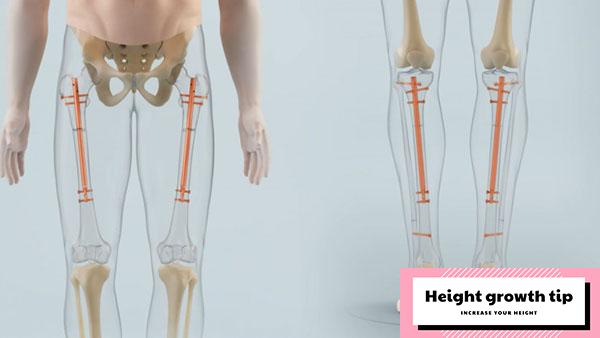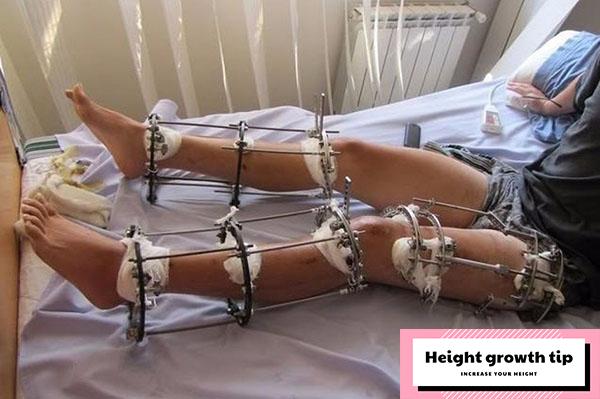Leg lengthening surgery isn’t merely a quick fix; it’s a meticulous process that demands careful consideration. It’s a path paved with challenges – both physical and financial. From the substantial investment required to the discomfort that accompanies the procedure, every step comes with its own set of hurdles.
Yet, despite the daunting nature of the journey, many are drawn to the allure of gaining those coveted inches. For some, it’s a quest for improved self-esteem, while for others, it’s about achieving a specific aesthetic ideal. Whatever the motivation, the decision to undergo leg lengthening surgery is a deeply personal one, often rooted in the desire for transformation.
So, as we embark on this exploration into the realm of leg lengthening surgery, let’s delve deeper into its intricacies, weighing the risks against the rewards and uncovering the motivations that drive individuals to pursue this path.
What Exactly Is Leg Lengthening Surgery?
Leg lengthening surgery is a highly complex medical procedure conducted within a hospital setting, harnessing the body’s innate ability to stimulate the growth of new bone while delicately elongating soft tissue, blood vessels, and nerves. The ultimate goal is to increase the length of a relatively shorter leg. The surgical procedure involves precise incisions in one of the leg bones, followed by the utilization of specialized metallic lengthening instruments to gradually create space between the segments of the bone.
The progression of this procedure typically occurs at a meticulously controlled pace, advancing by approximately 1 millimeter per day until the desired bone length is achieved. When the leg bones are intentionally disrupted in this manner, the body triggers a response, prompting the generation of new bone cells to bridge the gap. This bone distraction can be achieved through two primary methods: external fixators or internal lengthening nails.
In the case of external fixators, a sturdy metal framework is securely attached to the exterior of the leg and connected to the bone using an arrangement of pins, wires, and screws. This apparatus can be adjusted periodically, gradually increasing the gap between the two severed sections of the leg bone.
Alternatively, internal lengthening nails are inserted into the marrow cavity of the leg bones. These nails can be adjusted using a remote control that revolves around a magnet, effectively elongating the bones, much like extending a telescope.
Once the desired length is attained, the metallic lengthening instruments remain in place for several months to ensure complete healing and consolidation of the bone. Subsequently, another surgical intervention is performed to remove the metal devices, completing the intricate process.

What is the Purpose of Leg Lengthening Surgery?
Leg lengthening surgery serves a crucial purpose in the realm of orthopedic medicine, addressing the issue of leg length discrepancies with precision and care. This condition can arise from various origins, encompassing congenital factors or the aftermath of traumatic injuries. The essence of this surgical intervention lies in its ability to restore balance and harmony to the human frame, ultimately enhancing an individual’s mobility and overall quality of life.
Leg length discrepancies, often resulting in one leg being shorter than the other, can stem from a myriad of sources. These include birth-related injuries that affect bone growth, conditions like cerebral palsy, a history of muscle strain or shortening, fractures, poliomyelitis, or past lower leg injuries, as well as Legg-Calve-Perthes disease. The convergence of these factors necessitates the need for leg lengthening surgery, which seeks to rectify these imbalances and bring about improved alignment and functionality in the lower limbs.
In essence, the purpose of leg lengthening surgery is to orchestrate a symphony of precision and healing within the human body. It is an endeavor that seeks to realign the body’s foundation, ensuring that individuals can stand tall and move freely with confidence.
Determining the Optimal Age for Leg Lengthening Surgery
The quest for the optimal age at which to embark on the journey of leg lengthening surgery is a nuanced one, guided by an individual’s unique circumstances and the underlying reasons for pursuing such a procedure. Broadly speaking, this transformative surgery is most frequently undertaken by adolescents and young adults who have traversed the bulk of their skeletal growth.
In the case of children grappling with significant leg length disparities due to congenital factors or growth plate-related injuries, the decision to proceed with surgery may arise at an earlier juncture, typically around the ages of 10 to 15. Such a proactive approach aims to mitigate the potential impacts of these discrepancies on a child’s physical development and overall well-being.
Conversely, for those individuals who grapple with acquired leg length inequalities stemming from injuries or medical conditions, the strategic timing of the surgery typically hinges on the closure of their growth plates. This critical juncture usually falls around 14 to 16 years old for girls and 16 to 18 years old for boys, ensuring that the surgical intervention seamlessly dovetails with the natural progression of their physical growth.
Ultimately, the art of discerning the ideal age for leg lengthening surgery is a collaborative endeavor, uniting the wisdom of a seasoned orthopedic surgeon with the specific intricacies of an individual’s medical history. This shared decision-making process takes into account factors such as bone maturity, overall health, and a comprehensive evaluation of the potential benefits and risks associated with the surgery. The result is a harmonious symphony of medical expertise and individualized care, guiding each patient toward a future characterized by enhanced mobility and a renewed sense of equilibrium.
What to expect?
Before the Surgical Procedure:
Prior to embarking on the transformative journey of leg lengthening surgery, your medical practitioner will furnish you with precise guidelines to prepare you for this significant undertaking. These preparatory directives encompass:
- Fasting: Abstaining from food and beverages after the stroke of midnight on the eve of your surgery day.
- Medication: Cessation of any supplementary or herbal remedies, as stipulated by your physician.
- Transportation: Ensuring that logistical arrangements for your transportation to the surgical facility and from the hospital are securely in place.
- Personal Necessities: Assembling all essential personal care items that may be required during your hospital sojourn.
It is conceivable that your doctor may issue further instructions that necessitate your attention and compliance, tailored to your specific case.
During the Surgical Operation:
Amid the surgical procedure itself, the skilled surgeon will typically elect one of the two aforementioned methodologies, both necessitating the administration of general anesthesia, rendering the patient completely unconscious throughout the duration of the operation.
The principal techniques employed during leg lengthening surgery may encompass:
- Bone Osteotomy: The surgeon will delicately execute strategic incisions in the bone at precise locations.
- Metallic Stabilization: Introduction of metal pins and screws into the bone to confer stability and reinforce the leg’s structure.
- External Fixation: An external metallic apparatus will be affixed to the aforementioned pins, gradually exerting controlled force on the incised bone area, thereby catalyzing the genesis of new bone tissue.
Upon attaining the desired leg length, the surgeon will proceed to remove the fixation pins. It should be noted that the extent of attainable extension may be somewhat constrained, typically hovering around the vicinity of 3 inches.
After the Surgical Procedure:
Following the surgical intervention, your medical practitioner will dispense meticulous directives pertaining to the postoperative convalescent phase. Depending on individual circumstances, some patients may necessitate a prolonged hospital stay for observance and participation in physical therapy regimens. Alternatively, others may be advised to partake in gentle activities while relying on crutches to facilitate mobility. Additionally, to augment bone growth, your doctor might prescribe calcium and vitamin D supplements.
The holistic process of limb elongation typically spans the duration of approximately a year, commencing with the inaugural surgery and culminating in the removal of the external fixator. Nevertheless, it is imperative to acknowledge that this timeline is subject to variance contingent on the chosen method and the patient’s response to the treatment.
Although leg lengthening surgery boasts an impressive success rate of approximately 95%, it remains incumbent upon patients to exercise due diligence by engaging in comprehensive discussions with their healthcare provider concerning the potential side effects and associated risks before embarking on this transformative journey.

How to Naturally Increase Your Height and Maximize Growth Potential
Embarking on a journey to increase your height through leg lengthening surgery can be an arduous and costly endeavor, with expenses starting at approximately $75,000 in the United States. Fortunately, there are natural and effective methods that teenagers can embrace during their developmental years to optimize their height potential.
Embrace a Nutrient-Rich Diet:
Proper nutrition plays a pivotal role in fostering optimal growth. A well-rounded diet should encompass an array of fresh fruits, vegetables, proteins, dairy, and whole grains. Paying special attention to an adequate intake of calcium and vitamin D is imperative for bone health, a critical factor contributing to overall height.
Prioritize Adequate Sleep:
While you slumber, your body releases human growth hormone (HGH), a crucial catalyst for growth. Inadequate sleep can impede the production of HGH and other essential hormones, potentially hindering height development. It is advisable for teenagers to aim for a restful 8 to 10 hours of sleep daily to support tissue growth.
Engage in Regular Physical Activity:
Engaging in consistent physical activity offers a multitude of health benefits. It fortifies bones and muscles, boosts the production of HGH, and helps maintain a healthy weight. Teenagers should target at least 30 minutes to an hour of daily exercise and sports, encompassing activities like yoga, push-ups, jump rope, cycling, or swimming.
Consider Height-Enhancing Supplements:
Specific supplements are tailored to bolster bone health and growth. If an individual’s regular diet lacks essential vitamins and minerals, incorporating supplements can help rectify nutritional deficiencies. In some instances, a medical professional may recommend supplements containing synthetic HGH if there is an issue with natural HGH production.
In summary, the decision to undergo leg lengthening surgery for height augmentation hinges on personal preferences and circumstances. Although this surgical approach offers certain advantages, it is not without considerable risks and challenges. Therefore, it is crucial to engage in an in-depth and transparent dialogue with a qualified medical practitioner to ascertain whether this surgery aligns with your needs.
Factors such as the extent of leg length discrepancy, overall health status, and individual goals should be meticulously pondered before proceeding with surgery. Moreover, exploring natural strategies to optimize height growth, such as maintaining a wholesome diet, ensuring ample sleep, participating in regular physical activities, and contemplating height-enhancing supplements, can be valuable alternatives for those striving to unlock their height potential sans surgical intervention.
Ultimately, well-informed decision-making, comprehensive medical guidance, and realistic expectations are paramount in ensuring the most favorable outcomes, whether one is contemplating leg lengthening surgery or other avenues of height enhancement
- Related post: What is the standard height of a 6 year old child?

